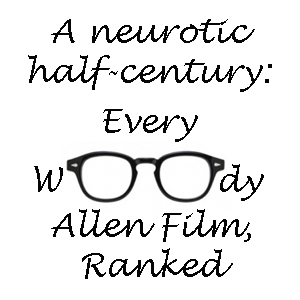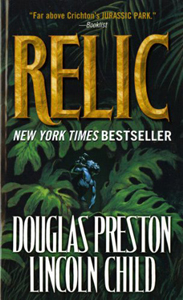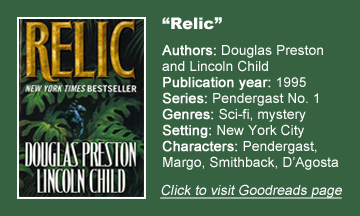As it did for many fans, “Relic” (1995) launched my appreciation for the books of Douglas Preston and Lincoln Child – both as a duo and as individual authors. I’ve devoured all of their fiction since their co-authored debut, and in some ways they have improved as writers, but always in the back of my mind was how good “Relic” was and how I’d like to re-read it.
I had recalled it being better than Michael Crichton’s “The Lost World,” which came out the same year.
Museum has character
On this re-read, “Relic” is still great, and it is a richer, deeper text than “The Lost World” (which I also love) in terms of scares, and it holds its own in terms of intriguing pseudo-science.
It becomes its own thing thanks to: the New York Museum of Natural History (in real life it’s the American Museum of Natural History, which Preston explores in his 1986 nonfiction tome “Dinosaurs in the Attic”); a handful of characters whose personalities make us want to spend more time with them (and which the authors oblige us in future novels); and a gripping epilog that reveals the whole answer to the Museum Beast’s nature as a delicious come-down from the tense evasion drama.
To be fair to Crichton, he got there first, and P&C tap into several of the same themes as the “Jurassic Park” duology. Most notable is the idea of a prehistoric yet intelligent creature. The moment when we learn Mbwun can open doors is as creepy as when we find out velociraptors can do it in “Jurassic Park.”
Additionally, “Relic” follows “JP” in exploring the good and bad of computer technology. Our heroes learn crucial information about the beast’s morphology and intelligence from the predictive computer program developed by Dr. Frock and Greg Kawakita.
But on the other hand, the museum turns its security for the Superstition exhibition grand opening over to a computer, and it locks the guests behind immovable steel doors, trapping them inside with the beast. P&C have a penchant for grim near-parody in their writing, wherein FBI Agent Pendergast – tracking the murders from New Orleans — predicts a bureaucratically borne nightmare but no one listens to him.
The dark comedy comes out here when thousands of guests trample out of the hall – leaving several dead – after the discovery of a headless corpse amid the exhibit. Further bureaucratic incompetence comes from New York FBI director Coffey’s decisions, which are rooted in fear of blame.
Stealthy Pendergast debut
This is the first Pendergast novel (it would later be labeled “Pendergast No. 1” in bookseller descriptions), but the New Orleans FBI agent isn’t introduced until chapter 14. I suspect the authors didn’t intend for him to be a breakout star, as this is an ensemble piece.
Here, Pendergast is a notable contrast to Coffey in that he’s competent, and he admits to a tendency to not suffer fools gladly, but his quirks aren’t wholly in play yet. We do get some surprisingly early backstory when he tells of the hunting skills of his late wife.

Margo Green, a graduate student working on her dissertation, is the closest to a main character and audience surrogate. She works under wheelchair-bound genius Dr. Frock – who I kept a close eye on here, recalling his role in the sequel, “Reliquary.”
NYPD Lieutenant Vincent D’Agosta is on hand with equal doses of blue-collar dedication and foul language. And although some look askance at Bill Smithback for his hunger to tell this story in a bestselling book, his unkempt hair and willingness to skirt rules are ultimately appealing to the others, especially young Margo, whom Smithback takes on as a sort of sidekick.
“Relic” features a huge cast of characters, and other than the main quintet (who are either in the movie or future books, or both), I had forgotten a lot of them.
A highlight is George Moriarty, an awkward curator with a crush on Margo that’s nicely underplayed. It’s impressive how we know many people well by the end, but P&C don’t go off on long tangents about their lives outside of these events.
More details than the film
The huge cast is partly to provide victims for the hypothalamus-craving Mbwun, of course, and partly to show just how huge the museum is – it covers six city blocks. Because the place is so massive, there’s verisimilitude to the idea that a murderer is loose inside the museum yet people are still working there.
The 1990s were before working from home became an easy thing, and even today I bet the museum holds cutting-edge equipment that needs to be used in person.
Plus, guests are still visiting. This is the Big Apple, where murder is par for the course, and rumors that a beast is responsible only adds to the appeal.
I’m an apologist for the 1997 movie, and I understand why it made trims and simplifications, but it plays a lot like an appetizer for the main course that is the deliciously detailed book.
Without letting up on the mystery’s momentum, P&C take us through storage rooms filled with dinosaur bones, elephant fossils and human artifacts, noting that less than 1 percent of the collection is on public display at any given time.
I also adore the architecture. The prone-to-flooding subbasement is so old and unused it doesn’t have accurate blueprints. And I like how Smithback can research his book on the Superstition exhibit right inside the museum, and how he favors cubbies deep in the stacks of the on-site library, so he can better focus.
An elite thriller
The museum is the “character” I most wanted to follow into subsequent books. But I also dig the human characters, for whom “Relic” is their proving ground.
In future novels, P&C would often note the measure of fame gained by Pendergast, Smithback, D’Agosta and Margo for their roles in the Museum Beast mystery.
Nothing can top reading “Relic” for the first time, as it opened my eyes to adult page-turning thrillers back in the day. I was a smidgen less enthralled on this re-read, only because I had built it up so much in my head and I knew the solution to the mystery.
But it deserves its position as an elite example of the form. In NPR’s 2010 rankings of the best 100 thrillers of all time, “Relic” ranks No. 64. (“The Cabinet of Curiosities” also makes the cut at No. 72. If you’re curious, “Jurassic Park” is at No. 14 and “The Lost World” didn’t chart.) That’s a great compliment to the 63 books above it.


